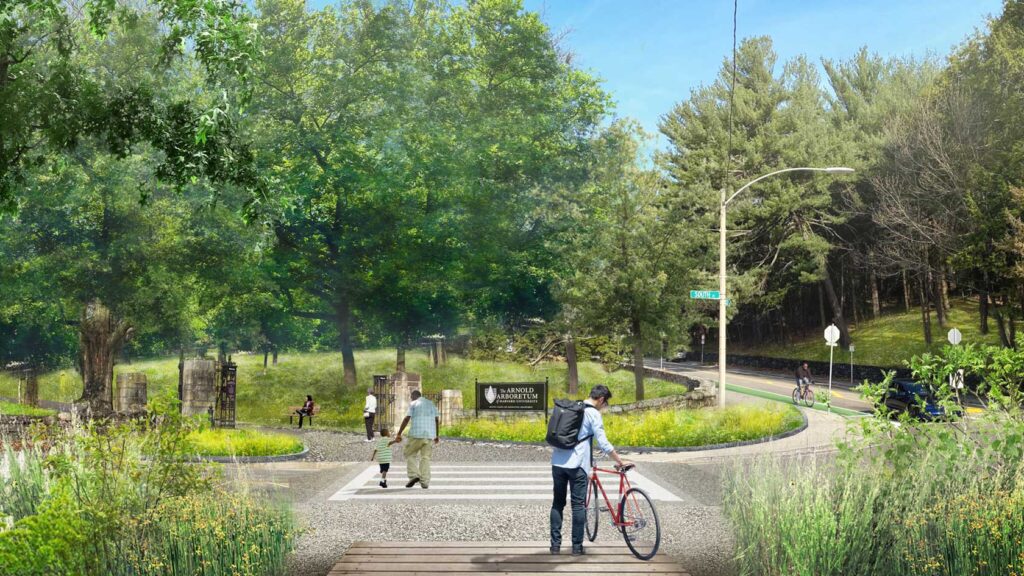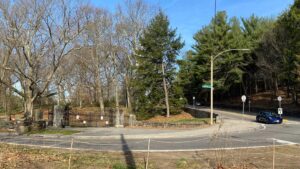With new renovations, Arnold Arboretum looks to open gates and build bridges

As one of Boston’s largest, free institutions, the Arnold Arboretum has a lot of potential to be a major resource for community members across the city.
But it’s a potential that the park, which is owned by the city and leased to Harvard University under a 1,000-year agreement, hasn’t always lived up to, said Jon Hetman, associate director of external relations and communications at the Arboretum.
“I think during the pandemic, we got our minds around how many people were coming and using the Arboretum as a resource,” he said. “I think it made us realize what a bad job we were doing in terms of welcoming communities to our landscape and having resources for people to understand what our landscape is and how they can engage with this landscape and with the plants here.”
That has especially been true for neighborhoods immediately surrounding the park, he said, many of which include environmental justice communities — six of the census tracts that touch the park qualify as EJ communities, all under at least the qualification that 40% or more of the population is made up of minorities.
New renovations in the park, part of a 150th-anniversary update to the space, look to open gates at the Arnold Arboretum — literally.
At five of the Arboretum’s nine entrances, the organization is planning to undergo renovations with a list of goals to reshape the entrances and make them more welcoming to community members.
Those gates — the Arborway Gate at the north of the park, the Washington Street Gate across from Forest Hills station, the Beech Path or South Street Gate on the park’s east side, the Poplar Gate where Bussey Street and South Street intersect and the Walter Street Gate on the park’s southwest side — were each selected based on neighboring environmental justice communities, access to adjacent health institutions like Faulkner Hospital or proximity to city or state infrastructure projects.
Danny Schissler, the Arboretum’s head of operations and projects, said that the Poplar Street Gate, the Washington Street Gate and the Walter Street Gate are the top three priorities, given their proximity to environmental justice communities.
Eventually, the Arboretum is aiming to renovate all nine gates.
The effort also includes the addition of a new entrance to the park at Arboretum Street, cleaning and restoring a previously, muddy and grimy tunnel under the Needham Line commuter rail tracks that will allow a new way for Roslindale residents to enter the park.
That new entrance is expected to officially open in spring of 2025.
For the renovations of the other five entrances, in some cases, the work starts with something as simple as opening iron gates that, decades ago, were welded shut. But a donor-funded campaign with a goal of $12.5 million is also looking to support work making the entrances more welcoming and physically open while maintaining and restoring historical aspects of the entrance, some of which date back to the original designs of the park in the late 1800s.
“Our gates and our stone walls are some of the treasures of the Arboretum. … The idea is not to replace those features, but to restore them.” said Schissler.
At the park’s southern Poplar Gate, the first of the entrances to see renovations, the massive stone pillars of the entrance were dismantled to be reconstructed with a stronger modern core. The decorative ironwork was sent away for restoration. And the walls are intended to be rebuilt largely using the original construction techniques: dry-stacked puddingstone.
The renovations at all five sites in the first phase will focus on making the entrance more attractive and appealing, better communicating to would-be — or could-be — visitors that they are spaces to invite entry and use, rather than walk by and ignore.
In renovating the space, the team at the Arboretum has been working to make sure all the entrances are compliant with the Americans with Disabilities Act and have been working with the Boston Disabilities Commission to make sure the entrances meet city accessibility standards as well.
The Arboretum, too, is trying to bring its collection of plants out to the street, Hetman said. At most of the renovated gates, new plantings will look to showcase both what is grown in the park, as well as the vision of Frederick Law Olmsted, who designed the Arboretum as well as the Emerald Necklace chain of parks that includes it.
Hetman pointed to the Walter Street Gate, on the west side of the park, as an example of the change they’re hoping to see. That space is currently paved over with asphalt and has long been used as an eight-spot parking lot.
“This is all remnants of the 20th century, and what was done to make Olmsted’s grand design fit the needs of the 20th century,” Hetman said. “What we’re thinking about now is dialing that back a bit, and thinking about what Olmsted and what the framers of the Arboretum intended the Arboretum to look like, not only on the inside, but from the outside.”
Schissler said that the Walter Street entrance will feature a “gingko grove.” At the Arborway Gate on the north side of the park, the Arboretum plans to plant a tree that could eventually grow to 60 feet tall.
Similar greening efforts will be included at four of the gates. The fifth — the Washington Street Gate, right across from Forest Hills station — doesn’t have the physical space to add plantings, but plans for that renovation will include removing a long stretch of fence that has cut visitors off from the planted area of the Arboretum.
“[Now,] you see this 150-foot long chain link fence when you approach that gate, so first and foremost, we’re like, ‘chain link has got to go,’ right?” Schissler said. “Let’s open the view. Let’s make this feel like a porous boundary that people can come through.”
And the greening efforts also mean less paved surfaces, an important inclusion in a time when the city and region are increasingly focused on the impacts of water retention and urban heat.
“The less pavement, the better at the Arboretum. We’re all about the plants, we’re all about the landscape, and we’re all about being a good neighbor to the rest of the city,” Schissler said. “We have 281 acres of green space here, and that means maximizing environmental and ecological benefits for the rest of the city.”
The signs at the entrance will get a refresh, too, as part of a stab at telling everyone what the space is and that all are welcome.
Currently, the sign shows the Arboretum’s logo — a majestic pine-like dawn redwood tree — and recognition that it is part of the Boston Parks and Recreation Department. That design, Schissler said, can be a bit of an enigma for community members who don’t know what the Arboretum is.
Instead, the new signs will say “The Arnold Arboretum, Harvard’s Museum of trees. A Boston public park. Free and open to all.”
“It’s a subtle thing, to change your main sign and just slightly change the wording and the fonts and the size, but it is so important because that type of immediate communication at our walls and at our gates is so crucial to nail, otherwise you come off feeling like, ‘this is not a place for me,’” Schissler said.
And underlying all the efforts is a broader push to connect with, and welcome surrounding neighborhoods into the Arboretum in many ways. In recent years, the Arboretum has made all its programming free. The organization is also looking to increase language access and interpretive signage and materials in the park and its operations.
Schissler pointed to conversations with community leaders in the Archdale neighborhood — the same area that will be served by the Arboretum’s new entrance — that have shaped educational programs and created a way to advertise those offerings to youth in the community who might not otherwise have heard of or engaged with them.
A free, summer-camp type program, the Arboretum Young Scientists program, which recently finished its third year, welcomes seventh and eighth graders from Boston Public Schools into the park to foster an interested in science subjects in nature.
The Arboretum, in the past year, also created its Arboretum Families Program to build connections with families in the area, especially those in Boston Public Housing developments nearby. Through that effort, the Arboretum has hosted events and started new conversations to foster environmental appreciation and community ties.
For Schissler, this moment is an opportunity for the Arboretum to forge new connections with surrounding communities that have previously been cut-off from the space, both physically and culturally.
“Opening entrances is, in some ways, kind of a passive thing,” he said. “But bridge-building with communities that have been cut off from access needs to be an active process where you’re going out and creating relationships and trust. This is, really, a new era for us.”







